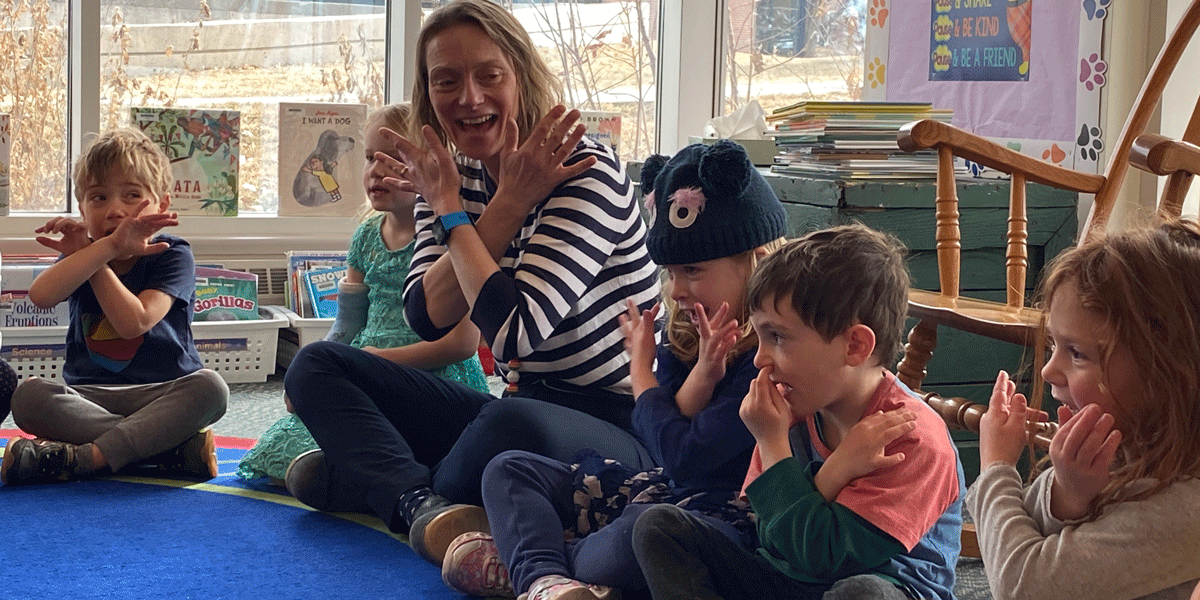The age-old adage is true—kids really do say the darndest things. That’s how the terms “Craftbrary” and “Musicbrary” were coined—by some Colorado Academy Pre-Kindergartners who were “Dr. Seussing” their own words.
In the last couple of years, the Pre-K library experience has been enhanced with the addition of Craftbrary and Musicbrary, where students do more than hear stories and check out books. During these enrichment times, Pre-K students are asked to further connect with books we read and express themselves through music and art activities.
For the students, Craftbrary and Musicbrary times are learning in disguise! Colorado Libraries for Early Literacy lists five early literacy practices that are meant to help a child build and nurture a strong foundation for reading and learning. These five practices include reading, writing, talking, singing, and playing—all of which are incorporated into the library’s craft and music lessons. Music teacher Nora Golden, Librarian Mary Leyva, and I endeavor to further Pre-K understanding of the themes, characters, and artistic styles in the books we read—and we do this by embracing all five early literacy practices.

Craftbrary: Connect and express
On a Craftbrary day, students hear a story and then engage in a craft activity inspired by the books we’ve read. For example, we recently read Janet Stevens’ picture book The Great Fuzz Frenzy, about a community of prairie dogs who are simultaneously terrified and energized by a mysterious yellow orb (a tennis ball) that falls into their underground dwelling. Pre-K students colored a prairie dog and then glued tennis ball “fuzz” onto their creations, just like the characters in the book do to dress up. This craft provided an opportunity to make a connection not just with the story, but certain words, like “texture,” and their real meaning.
Musicbrary: Connecting to more than the story
On a Musicbrary day, we read a story and then have the students participate in active rhymes, songs with movement, and sometimes even act scenes that connect to the day’s theme. We recently read stories about farm and ranch animals and then learned a movement song called “Wake up you lazybones” about a lazy rancher and his herd of cattle. “It is the most natural things for students to read, sing, and move together,” says Nora Golden. “They will remember the books, the messages, and the themes better because they’ve made a musical and kinesthetic connection.” Acting out a story helps them to better remember what happens and allows them to accurately retell that same story, an important part of Pre-K curriculum. The more Pre-K students hear and play with rich language, the better their vocabulary becomes and the better able they are to understand and connect with future stories.
Within Craftbrary and Musicbrary times resides an organic fluidity and spontaneity that can adhere tightly to Pre-K curricular themes or wander off into new areas, often ones brought about by the children themselves. We can dive deep into a story with a connecting craft activity or music and movement, allowing students to express themselves in new ways and continue to develop connections and understandings.

Fun and educational
Often when we start on a book-related activity, students will take the project in a direction that we had not even thought of—just like when we read Stellaluna, and the students sang a song about bats for us that they had learned in the Pre-K Cottage. Pre-K kids made a connection from the story to the classroom and made sure to share it and teach it to their unsuspecting Specials teachers. In Craftbrary and Musicbrary, these connections happen often.
Craftbrary and Musicbrary help kids make and bridge connections they are already creating in the classroom, on the playground, and in their everyday life, offering visual and auditory connections to stories and themes. It also provides a time in the library that is not about checking out books, but about reading, existing with a story, creating from story, and understanding the relationships between stories, art, and music. In turn, we are all sharing ideas with one another and developing our own community through the story, its themes, lessons, and the related activities we do with it.
Craft and Musicbrary are fun and educational. These added enrichment times in the library foster connections from stories to music to what Pre-K is learning (both in and out of the classroom) and to the world around them in a fun and joyful way.
